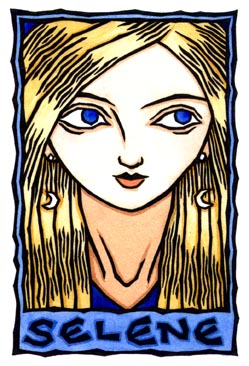It's odd. This time last year I could feel the veil thinning so profoundly that I feared it would tear. This year I can't tell at all.
Okay, it's not that odd.
See, I live in an old house. A
very old house, for this area at any rate; one that's a good two hundred and fifty years old, an old New England colonial, the kind with the enormous central chimney and a fireplace in every room. Now, it's a lovely quaint house, with the clapboards and twelve over twelve windows, don't get me wrong, but it comes with a bit of, shall we say,
baggage.And I grew up here. I spent some time away from it, and have come back to it since; but I was a child in this house. Which is its own kind of baggage, I know.
Besides being
my childhood home, it was
also the childhood home of a certain murderer, now, thankfully, deceased, who was a child living here in the fifties; my father, in fact, bought the house from his mother. There are tales of plastering over bullet holes in one of the attic rooms where he supposedly had taken pot shots at flies with his BB gun.
Now, all that might sound like a delightfully thrilling little bit of history, something to spook kids sitting around a campfire at night. Yeah, well,
except it's true.And except for the fact that I am a person given to anxiety, and have been so all my life. I have never, unsurprisingly, understood that idea about kids liking to be scared; for me, that is something
dearly to be avoided. I am still, at forty years old, afraid of the dark.
And besides the murderer who lived here, this house is, like I said, two and a half centuries old. I once told my best friend that I was afraid of ghosts, and she said, 'Well,
yeah,' (actually, the way she said it it was more a 'well,
duh') 'you live in a haunted house.' And that will make me feel better
how exactly?
Thanks, Tracey.
And there I was last year, or here I was last year, in this house, ultra-sensitive to the thinning veils around me. I was seeing things out of the corner of my eye
all the time. I would come down into the kitchen to find my mother just leaving the room, only it wasn't her, and there was no one down there; or it would slowly come to me that there was a man standing over there in the piano room; or I would get up in the middle of the night and nearly trip over a cat who wasn't there; never mind finding Emily, curious, bent over me watching me while I was sleeping.
Jesus Christ; for a nervous and naturally anxious sort, these things were
just not good for me.
So I shut it off. Literally; I imagined a wall, on which was a series of outdoor taps, like the kind you attach a garden hose to. And I went up to the one labelled 'ghosts', and I shut it off. Completely. Not even a drip. And, periodically, over the course of the last year, I have checked on it, to make sure it is still off. Off, and quite dry.
And I have to say this last year I've been much better on the anxiety front. So much, in fact, that this year I found myself actually enjoying autumn, the colors of the trees and the crisp air and all, which, unlike pretty much every other Pagan in the entire world, has always been one of my
least favorite seasons. And I also find myself very much into Hallowe'en, and (and this is
very much an artist thing) craving the color scheme of black, ash grey, pumpkin orange, and electric midnight blue. It's kind of funny, actually.
I am relaxed and free.
But I can't feel the veil thinning
at all. It is like I have cotton in my ears.
It is not ideal, no, and I know this; but, still, for now, I will take it.







